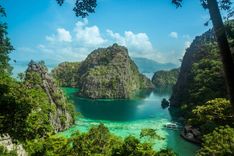#6 Mabahang Buhangin, Calaguas
The coffee-like sand and salty sea air of Calaguas Island in Camarines are enough to wake up even the tiredest of city slickers. Its main beach, Mabahang Buhangin, is a sight to behold, with azure water hugging a mile of wild jungle coastline.
This is one for adventurous souls: expect no phone signal, no ATMs (bring cash), and only the wilderness as your playground.
Hike to the tip of Mabahang Buhangin (translated to “long sand,” which implies how much of a sweat you’re going to work up), explore its secret coves, or kayak across the glimmering sea, with water so clear it’ll look like you’re floating.
How to get to Mabahang Buhangin
From Manila, travelers can brave 14 hours of zigzagging bus routes and long boat rides to arrive on these fine white shores, but once here, you’ll be thankful you made the journey.
There’s also an option to take a one-hour flight by seaplane to Daet, followed by a bus to Vinzons, a tricycle to the port, and then a two-hour boat ride to Mahabang Buhangin, Calaguas Island—a complicated journey, but one that will get you to this glorious beach in under five hours.
When to visit Mabahang Buhangin
For a smoother boat ride, aim for early morning departures. Avoid visiting from July to December, as the typhoon season often brings rough seas and boat cancellations. This beach is pretty secluded, so be sure to pack wisely (more on that in our travel health tips for the Philippines).














